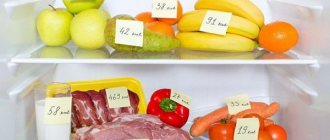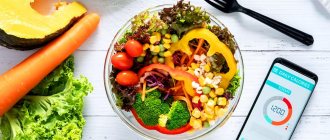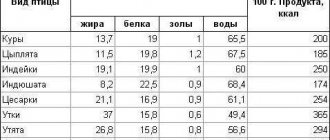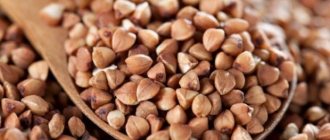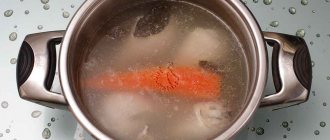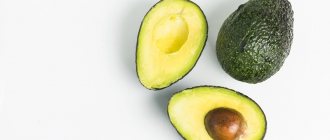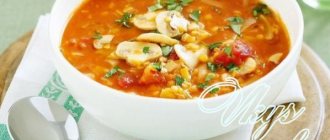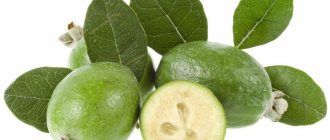Is it necessary to calculate nutritional and energy values?
The amount of kcal in a product is important information for consumers, which is why each manufacturer is obliged to accurately calculate all the calorie content of the product and indicate the information obtained on the packaging of the finished product.
According to the requirements of TR CU No. 022/2011 “Food products regarding their labeling,” information about calorie content must be indicated on the consumer packaging of any food product, which means that calculating the calorie content of dishes is a mandatory procedure for all food manufacturers.
What is the calorie content of foods and how to calculate it?
The peculiarities of losing weight often lie in the fact that it is necessary to count calories. How can you find out the number of calories in a particular product? This is where the label or calorie tables come to the rescue. There are programs that allow those losing weight to count calories.
If you don’t have anything like this at hand, then it’s worth knowing how calories are calculated.
All food consists of the following components: proteins, fats, carbohydrates, water, dietary fiber in the form of fiber and pectins. Some products may contain alcohols and organic acids. The food contains vitamins and minerals.
Scientists use 1000 calories or 1 kilocalorie when counting, denoted as kcal.
1 gram of nutrients contains the following number of calories:
- fats contain 9 kcal;
- alcoholic drinks (ethanol) contain 7 kcal;
- protein products contain 4 kcal;
- carbohydrates contain 4 kcal;
- products containing organic acids have 3 kcal;
- products such as sorbitol, xylitol, etc. will contain 2.4 kcal;
- dietary fiber is 2 kcal.
Then you just need to do the calculations to get the number of calories you eat.
Who should carry out the calculation of nutritional and energy values?
The calculation of the calorie content of dishes should be carried out by a specialist who has all the necessary knowledge in the field of drawing up regulatory and technological documentation for food production. To calculate the nutritional and energy value, you must know exactly the energy coefficients of all types of substances and determine exactly what calorie content the dish will have, depending on the method of its preparation.
The single portal “One Window” specializes in the development and execution of all types of regulatory, technical and operational documentation for the production of products. The specialists of our portal will help you quickly obtain all the necessary documents, calculate the energy value and calorie content of products in order to comply with all legal regulations in the process of carrying out activities.
How to effectively calculate the calorie content of foods?
Counting will give results if you know exactly how many grams of product you eat. The easiest way to find out is to measure portions using an electronic kitchen scale. The number of calories is usually given per 100 g of product. Information about how much the product weighs is also given on its packaging.
It can be difficult to determine the calorie content of some foods based on weight, such as a slice of bread and butter and a piece of cheese. In this case, weigh the bread and cheese separately. Please note that dry foods weigh less than, for example, a piece of cake or chicken breast.
What is needed to calculate the calorie content of foods?
To establish the nutritional and energy value, first of all, you should decide which indicator you need to obtain. Food manufacturers and managers of catering establishments often confuse them, passing them off as one another.
Nutritional value is a criterion characterizing the balance of a product. To determine it, information about the composition of the product is compared with the available standard nutritional values. The result is expressed as a percentage of a given norm. Energy value is the amount of energy that the human body receives when consuming certain products. Expressed in calories, kilocalories, joules.
Calculation of the energy value of products and food is carried out using the BZHU protocol, which indicates the amount of proteins, fats and carbohydrates in the product. The indicator is determined in one of the possible ways:
- Calculated. When applying this method, every ingredient that is included in the product is taken into account. Next, depending on the percentage, the required indicator for the hotel component is determined.
- Laboratory. The Kjeldahl method is used. Liquid chromatography or spectrophotometric techniques are also used. Each of the indicated options must be carried out in compliance with state standards.
When organizing laboratory tests, the following standards can be used:
- GOST 25001-2017;
- GOST 33409-2015.
Note! Calculating the nutritional value of food products is a mandatory step required to indicate information on the label of a product, on the menu or other sources. Displaying false data is prohibited by law. If such violations are discovered, the entrepreneur is held accountable under Article 14.8 of the Code of Administrative Offenses of the Russian Federation. When asking for help in determining the required indicators, an entrepreneur must provide a number of documents and information. Among them:
- registration certificates of an individual entrepreneur or company (copies of TIN, OGRN);
- a list of food products, dishes and other goods for which research needs to be conducted;
- information about the composition, raw materials used, technological process;
- information about the regulatory documents according to which the release of goods is organized.
The exact list of what is required for the procedure is determined individually during a preliminary consultation.
Energy value of food (all figures per 100 g of product)
Vegetables and greens
| Product name | kcal | fats | squirrels | carbohydrates |
| Avocado | 223 | 23,5 | 1,9 | 6,7 |
| Eggplant | 24 | 0,1 | 0,6 | 5,5 |
| Zucchini | 27 | 0,3 | 0,6 | 5,7 |
| Potato | 83 | 0,1 | 2 | 19,7 |
| Brussels sprouts | 12 | 0 | 1,2 | 1,7 |
| Cauliflower | 29 | 0 | 2,5 | 4,9 |
| White cabbage | 28 | 0 | 1,8 | 5,4 |
| Sauerkraut | 17 | 2,3 | 5,8 | 0 |
| Kohlrabi | 30 | 0 | 1,8 | 5,4 |
| Bulb onions | 43 | 0 | 1,7 | 9,5 |
| Bow feather | 22 | 0 | 1,3 | 4,3 |
| Leek | 40 | 0 | 3 | 7,3 |
| Carrot | 33 | 0,1 | 1,3 | 7 |
| Greenhouse cucumbers | 10 | 0 | 0,7 | 1,8 |
| Ground cucumbers | 15 | 0 | 0,8 | 3 |
| Olives | 538 | 51 | 5,2 | 10 |
| Sweet pepper (red) | 27 | 0 | 1,3 | 5,7 |
| Parsley | 45 | 0 | 3,7 | 8,1 |
| Radish | 20 | 0 | 1,2 | 4,1 |
| Radish | 34 | 0 | 1,9 | 7 |
| Turnip | 28 | 0 | 1,5 | 5,9 |
| Celery | 22 | 0 | 6,9 | 4,5 |
| Beetroot | 48 | 0 | 1,7 | 10,8 |
| Leaf lettuce | 14 | 0 | 1,5 | 2,2 |
| Greenhouse tomatoes | 14 | 0 | 0,6 | 2,9 |
| Ground tomatoes | 19 | 0 | 0,6 | 4,2 |
| Table pumpkin | 19 | 0 | 0,3 | 4,4 |
| Horseradish (root) | 71 | 0 | 2,5 | 16,3 |
| Dill | 30 | 0 | 1,8 | 5,6 |
| Garlic | 106 | 0 | 6,5 | 21,2 |
| Green beans (pod) | 32 | 0 | 4 | 4,3 |
| Spinach | 21 | 0 | 2,9 | 2,3 |
| Sorrel | 28 | 0 | 1,5 | 5,3 |
Fruits
| Product name | kcal | fats | squirrels | carbohydrates |
| Orange | 38 | 0 | 0,9 | 8,4 |
| Apricot | 46 | 0 | 0,9 | 10,5 |
| A pineapple | 48 | 0 | 0,4 | 11,8 |
| Watermelon | 38 | 0 | 1 | 22,4 |
| Banana | 91 | 0 | 1,5 | 22,4 |
| Cherry | 49 | 0 | 0,8 | 11,3 |
| Grape | 69 | 0 | 0,4 | 17,5 |
| Pear | 42 | 0 | 0,4 | 10,7 |
| Melon | 25 | 0 | 0,4 | 4,5 |
| Figs | 56 | 0 | 0,7 | 13,9 |
| Cranberry | 28 | 0 | 0,5 | 4,8 |
| Lemon | 31 | 0 | 0,9 | 3,6 |
| Garden strawberry (strawberry) | 37 | 0 | 1,2 | 8 |
| Currant (black) | 40 | 0 | 1 | 8 |
| Garden plum | 43 | 0 | 0,8 | 9,9 |
| Apples | 46 | 0 | 0,4 | 11,3 |
Dried fruits and nuts
| Product name | kcal | fats | squirrels | carbohydrates |
| Apricot without pit (dried apricot) | 272 | 0 | 5,2 | 65,9 |
| Raisins sultanas | 279 | 0 | 2,3 | 71,2 |
| Pitted plum (prune) | 264 | 0 | 2,3 | 65,6 |
| Rose hip | 253 | 0 | 4 | 60 |
| Dates | 281 | 0 | 2,5 | 72,1 |
| Peanut | 548 | 45,2 | 26,3 | 9,7 |
| Walnuts | 648 | 61,3 | 13,8 | 10,2 |
| Cedar | 270 | 23,2 | 6,9 | 6,2 |
| Forest (hazel, hazelnut) | 704 | 66,9 | 16,1 | 9,9 |
| Almond | 645 | 57,7 | 18,6 | 13,6 |
| Sunflower seeds | 578 | 52,9 | 20,7 | 5 |
| Pistachios | 318 | 27,5 | 9,3 | 6 |
Cereals and legumes
| Product name | kcal | fats | squirrels | carbohydrates |
| Hercules | 355 | 6,2 | 13,1 | 65,7 |
| Buckwheat (kernel) | 329 | 2,6 | 12,6 | 68 |
| Corn | 325 | 1,2 | 8,3 | 75 |
| Manna | 326 | 0,7 | 11,3 | 73,3 |
| Pasta | 356 | 0,9 | 11 | 74,2 |
| Millet | 334 | 2,9 | 12 | 69,3 |
| Wheat | 325 | 1,1 | 12,7 | 70,6 |
| Pearl barley | 324 | 1,1 | 9,3 | 73,7 |
| Rice | 323 | 0,6 | 7 | 73,7 |
| Barley | 322 | 1,3 | 10,4 | 71,7 |
| Beans | 58 | 0,1 | 6 | 8,3 |
| Soybeans | 395 | 17,3 | 34,9 | 26,5 |
| Whole peas | 303 | 1,2 | 23 | 53,3 |
| Shelling peas (canned green peas) | 323 | 1,6 | 23 | 57,7 |
| Lentils | 310 | 1,1 | 24,8 | 53,7 |
| Beans | 309 | 1,7 | 22,3 | 54,5 |
Dairy products
| Product name | kcal | fats | squirrels | carbohydrates |
| Cheese cheese (from cow's milk) | 260 | 20,1 | 17,9 | 0 |
| Yogurt (1.5% fat) | 51 | 1,5 | 5 | 3,5 |
| Full fat kefir | 59 | 3,2 | 2,8 | 4,1 |
| Low-fat kefir | 30 | 0,1 | 3 | 3,8 |
| Acidophilus milk | 83 | 3,2 | 2,8 | 10,8 |
| Homemade milk | 58 | 3,2 | 2,8 | 4,7 |
| Powdered milk | 475 | 25 | 25,6 | 39,4 |
| Condensed milk with sugar | 315 | 8,5 | 7,2 | 56 |
| Ryazhenka | 85 | 6 | 3 | 4,1 |
| Sour cream (fat content 20%) | 206 | 20 | 2,8 | 3,2 |
| Sour cream (fat content 10%) | 116 | 10 | 3 | 2,9 |
| Cream (fat content 20%) | 205 | 20 | 2,8 | 3,6 |
| Cream (fat content 10%) | 118 | 10 | 3 | 4 |
| Cheeses and curd masses | 340 | 23 | 7,1 | 27,5 |
| Processed cheeses | 226 | 13,5 | 24 | 0 |
| Dutch cheese | 361 | 27,3 | 26,8 | 0 |
| Poshekhonsky cheese | 334 | 26,5 | 26 | 0 |
| Russian cheese | 371 | 30 | 23,4 | 0 |
| Swiss cheese | 396 | 31,8 | 24,9 | 0 |
| Low-fat cottage cheese | 86 | 0,6 | 18 | 1,5 |
| Fat cottage cheese | 226 | 18 | 14 | 1,3 |
Oils, lard, etc.
| Product name | kcal | fats | squirrels | carbohydrates |
| Butter | 748 | 82,5 | 0,6 | 0,9 |
| Vegetable oil | 899 | 99,9 | 0 | 0 |
| Ghee | 887 | 98 | 0,3 | 0,6 |
| Creamy margarine | 744 | 82 | 0,5 | 1,2 |
| Mayonnaise | 627 | 67 | 3,1 | 2,6 |
| Pork bacon | 816 | 92,8 | 1,4 | 0 |
Meat, poultry, offal and sausages
| Product name | kcal | fats | squirrels | carbohydrates |
| Mutton | 203 | 15,3 | 16,3 | 0 |
| Beef | 187 | 12,4 | 18,9 | 0 |
| Beef udder | 173 | 13,7 | 12,3 | 0 |
| Beef kidneys | 66 | 1,8 | 12,5 | 0 |
| Beef liver | 98 | 3,1 | 17,4 | 0 |
| Beef heart | 87 | 3 | 15 | 0 |
| Beef tongue | 163 | 12,1 | 13,6 | 0 |
| Goose | 364 | 33,3 | 16,1 | 0 |
| Turkey | 197 | 12 | 21,6 | 0,8 |
| horsemeat | 143 | 7 | 20,2 | 0 |
| Rabbit | 199 | 12,9 | 20,7 | 0 |
| Chickens | 165 | 8,8 | 20,8 | 0,6 |
| Pork is fatty | 489 | 49,3 | 11,4 | 0 |
| Pork lean | 316 | 27,8 | 16,4 | 0 |
| Pork liver | 108 | 3,6 | 18,8 | 0 |
| Pork kidneys | 80 | 3,1 | 13 | 0 |
| Pig heart | 89 | 3,2 | 15,1 | 0 |
| Pig tongue | 208 | 16,8 | 14,2 | 0 |
| Veal | 90 | 1,2 | 19,7 | 0 |
| Duck | 346 | 61,2 | 16,5 | 0 |
| Boiled sausage Doctorskaya | 360 | 22,8 | 13,7 | 0 |
| Boiled sausage Lyubitelskaya | 301 | 28 | 12,2 | 0 |
| Boiled-smoked Cervelat | 360 | 27,5 | 28,2 | 0 |
| Boiled-smoked Amateur | 420 | 39 | 17,3 | 0 |
| Ham | 279 | 20,9 | 22,6 | 0 |
| Beef stew | 232 | 18,3 | 16,8 | 0 |
| Raw smoked brisket | 467 | 47,2 | 10,5 | 0 |
| Semi-smoked Ukrainian | 376 | 34,4 | 16,5 | 0 |
| Semi-smoked Minsk | 259 | 17,4 | 23 | 2,7 |
| Semi-smoked Krakow | 466 | 44,6 | 16,2 | 0 |
| Pork sausages | 332 | 31,6 | 10,1 | 1,9 |
| Pork stew | 349 | 32,2 | 14,9 | 0 |
| Pork sausages | 324 | 30,8 | 11,8 | 0 |
| Milk sausages | 277 | 25,3 | 12,3 | 0 |
| Russian sausages | 220 | 19,1 | 12 | 0 |
| Raw smoked Moscow | 473 | 41,5 | 24,8 | 0 |
| Raw smoked Amateur | 514 | 47,8 | 20,9 | 0 |
Eggs
| Product name | kcal | fats | squirrels | carbohydrates |
| Chicken egg | 157 | 11,5 | 12,7 | 0,7 |
| Quail egg | 168 | 13,1 | 11,9 | 0,6 |
| Egg powder | 542 | 37,3 | 45 | 7,1 |
Fish and seafood
| Product name | kcal | fats | squirrels | carbohydrates |
| Pink salmon | 147 | 7 | 21 | 0 |
| Sturgeon caviar punched | 123 | 10,2 | 36 | 0 |
| Sturgeon caviar granular | 203 | 9,7 | 28,9 | 0 |
| Chum salmon caviar granular | 251 | 13,8 | 31,6 | 0 |
| Pollock caviar, punched | 131 | 1,9 | 28,4 | 0 |
| Squid | 75 | 0,3 | 18 | 0 |
| Flounder | 88 | 2,6 | 16,1 | 0 |
| Carp | 96 | 3,6 | 16 | 0 |
| Smelt | 91 | 3,2 | 15,5 | 0 |
| Shrimp | 83 | 0,8 | 18 | 0 |
| Far Eastern shrimp | 134 | 1,2 | 28,7 | 0 |
| Crab | 69 | 0,5 | 16 | 0 |
| Bream | 105 | 4,1 | 17,1 | 0 |
| Pollock | 70 | 0,7 | 15,9 | 0 |
| Sea kale | 5 | 0,2 | 0,9 | 3 |
| capelin | 157 | 11,5 | 13,4 | 0 |
| Navaga | 73 | 1 | 16,1 | 0 |
| Marbled notothenia | 156 | 10,7 | 14,8 | 0 |
| Sturgeon | 164 | 10,9 | 16,4 | 0 |
| River perch | 82 | 0,9 | 18,5 | 0 |
| Sea bass | 117 | 5,2 | 17,6 | 0 |
| Blue whiting | 72 | 0,9 | 16,1 | 0 |
| Halibut | 103 | 3 | 18,9 | 0 |
| Carp | 121 | 5,3 | 18,4 | 0 |
| Salaka | 121 | 5,6 | 17,3 | 0 |
| Small saury | 143 | 0,8 | 20,4 | 0 |
| Large saury | 262 | 20,8 | 18,6 | 0 |
| Salmon | 219 | 15,1 | 20,8 | 0 |
| Herring | 242 | 19,5 | 17,7 | 0 |
| Mackerel | 153 | 9 | 18 | 0 |
| Som | 144 | 8,5 | 16,8 | 0 |
| Sterlet | 320 | 6,1 | 17 | 0 |
| Horse mackerel | 119 | 5 | 18,5 | 0 |
| Zander | 83 | 0,8 | 19 | 0 |
| Tuna | 96 | 0,7 | 22,7 | 0 |
| Cod | 75 | 0,6 | 17,5 | 0 |
| Cod (liver) | 613 | 65,7 | 4,2 | 0 |
| Acne | 333 | 30,5 | 14,5 | 0 |
| Sea eel | 94 | 1,9 | 19,1 | 0 |
| Pike | 82 | 0,7 | 18,8 | 0 |
| Hake | 86 | 2,2 | 16,6 | 0 |
| Ide | 117 | 0,3 | 18,2 | 0 |
Bakery products
| Product name | kcal | fats | squirrels | carbohydrates |
| Baranki | 312 | 1,3 | 10,7 | 68,7 |
| Corn flour | 351 | 1,7 | 9,6 | 22,1 |
| Rye flour | 326 | 1,1 | 6,9 | 76,9 |
| Premium wheat flour | 327 | 0,9 | 10,3 | 74,2 |
| Butter products | 297 | 4,5 | 7,6 | 60 |
| Creamy crackers | 397 | 10,6 | 8,5 | 71,3 |
| Wheat crackers | 331 | 1,4 | 11,2 | 72,4 |
| Drying | 330 | 1,3 | 11 | 73 |
| Wheat bread | 254 | 2,4 | 7,7 | 53,4 |
| Rye bread | 214 | 0,7 | 4,7 | 49,8 |
Answers to popular questions
How much does it cost and what does the cost of calculating the nutritional value of a product depend on?
The exact cost of services for calculating the nutritional value of a product can be obtained from the portal specialists. Factors influencing the final price are:
- the number of products for which calculations will be carried out;
- composition of products and list of ingredients included in them;
- the applicant has accurate information about the quantitative content of proteins, fats and carbohydrates in the product;
- The type of determination of the required values used is calculated or laboratory.
- the need to prepare additional documents for the applicant.
How to calculate calories in foods
Counting energy in food in the traditional manner may seem laborious at first glance, but over time, habit develops and it becomes an integral part of daily nutrition.
For this calculation, you need food calorie tables and a kitchen scale. You can easily find the table on our website or in bookstores. Note, however, that simply knowing the calorie content of individual foods is not enough to get the desired result.
No less important is the composition of the food we eat. Everyone knows that the energy that the body receives, for example, from sweets is not healthy or healthy. Therefore, you must ensure your daily calorie intake and balance it properly in terms of protein, carbohydrate and fat content.
Preparation to calculate the calorie content of the finished dish
A kitchen scale will help you calculate the exact volume of ingredients needed to create the proportions . A suitable model must be accurate to within 1 gram and contain an option to reset the tare weight.
In the future, the device will be useful in the culinary field: it will help you thoroughly follow the recipe. Without scales, calculating dishes from several products is problematic.
It is recommended to keep a separate diary . It is not enough to calculate the calorie content of the finished dish by ingredients; it is important to save the calculated data for later use. An endless return to the same exhausting mathematical operations will discourage any desire to engage in menu balancing.
It’s a good idea to find a suitable program or application for calculating the calorie content of complex dishes. You can start with several options, choosing the most attractive interface.
In addition to the design, it is important to track the level of error of the online calculator : small inaccuracies can slip through, but you should be wary of huge data discrepancies. The ideal test would be to compare the application numbers with the energy value indicated on the labels (factory calculations are the most accurate).
Try to make
the process of preparing certain recipes more unified : clear dosage, identical utensils, adjusted amount of water. With this approach, you quickly get the hang of things: already at the stage of preparing the ingredients, the final nutritional value will be clear.
a program that is necessary for every enterprise.
Tweet
Energy and nutritional value of the finished dish.
Today we will touch upon a very important question for any catering enterprise: what is the nutritional and energy value of a dish and how to calculate it?
NUTRITIONAL VALUE OF A DISH OR PRODUCT
– includes all the beneficial properties of a food product or dish and includes proteins, fats, carbohydrates, the entire chemical composition of the product, as well as micro and macro elements. Nutritional value is measured in grams
ENERGY VALUE OF A DISH OR PRODUCT
- this is the amount of energy that a person receives from a food product or dish during a biochemical reaction or the amount of heat generated in the human body. Energy value is measured in kilocalories (kcal) - units of thermal energy or kilojoules (kJ)
1 kcal = 4.184 kJ
Each element (proteins, fats, carbohydrates, etc.) of the nutritional value of a dish, when oxidized in the human body, releases a different amount of thermal energy.
Knowing the energy coefficient of each element, it will not be difficult to calculate the calorie content of any dish. So:
1 g of carbohydrates has a coefficient of 3.75 kcal
1 g of protein has a coefficient of 4.0 kcal
1 gram of fat has a coefficient of 9.0 kcal
1g organic acids: acetic acid 3.5 kcal; apple 2.4 kcal; dairy 3.6 kcal; lemon 2.5 kcal.
EXAMPLE:
It is necessary to calculate the calorie content of 130 grams of milk sausages, if it is known that 100 grams of the product contains; B – 11.0 g F – 23.9 g U – 1.6 g OK – no
- 130 grams of milk sausages contain: proteins 11.0 * 1.3 = 14.3 g fats 23.9 * 1.3 = 31.07 g
carbohydrates 1.6 * 1.3 = 2.08 g - Knowing the calorie coefficient of 1 gram of proteins, fats and carbohydrates, you can calculate the energy value of 130 grams of milk sausages: proteins 4.0 kcal * 14.3 = 57.2 kcal fats 9.0 kcal * 31.07 = 279.63 kcal
carbohydrates 3.75 kcal*2.08=7.8 kcal - Therefore, the energy value of 130 grams of milk sausages will be equal to: 57.2 + 279.63 + 7.8 = 344.63 kcal
This example shows how you can calculate the calorie content of an entire daily diet or product if its chemical composition is known.
.
HOW TO DETERMINE THE ENERGY VALUE OF A READY-TO-EAT DISH, TAKEN INTO ACCOUNT OF LOSSES DURING HEAT PROCESSING?
To answer this question you need:
1. List of all products included in the recipe. 2. Quantity of products in grams, using the net weight of the product.
Calculation of nutritional and energy value is carried out using the reference table 7. Chemical composition of Russian food products: Directory / Ed. corresponding member MAI, prof. I.M. Skurikhin, academician of the Russian Academy of Medical Sciences, prof. V.A. Tutelyana. – M.: DeLi print, 2002. – 236 p.
It should be noted here that the tables do not indicate losses during heat treatment of products. To solve this problem, you must use Table 4 of this reference book.
EXAMPLE:
Boiled chicken 140 gr.
100 grams of chicken contains B - 18.2 grams F - 18.4 grams U - 0.7 grams
In 140 grams of chicken: Protein 18.2 * 1.4 = 25.48 grams Fat 18.4 * 1.4 = 25.76 grams Carbohydrates 0.7 * 1.4 = 0.98 grams Knowing the calorie content of 1 gram of proteins, fats and carbohydrates, we calculate the energy value Proteins 4.0 kcal * 25.48 = 101.92 kcal Fats 9.0 kcal * 25.76 = 231.84 kcal Carbohydrates 3.75 * 0.98 = 3.68 kcal Theoretical energy value 140 gram of chicken is equal to: 101.92 + 231.84 + 3.68 = 337.44 kcal
Next, summing up the coefficient of digestibility and loss of products during cooking, we calculate the actual energy value of boiled chicken: Proteins 101.92 kcal * (100-4-8)/100 = 89.69 kcal Fats 231.84 kcal * (100-5-25) /100 = 162.29 kcal Carbohydrates 3.68 * (100-2)/100 = 3.61 kcal
The actual energy value of 140 grams of boiled chicken is: 89.69 + 162.29 + 3.61 = 255.59 kcal.
It should be noted that all calculations of the energy value of products are quite painstaking work. Today on the Internet there are a large number of programs with recipe analyzers, where when you enter the recipe for a dish, you will be provided with complete information on the nutritional and energy value of the dish you are interested in. All you have to do is enter the received data into your technological or technical flow chart.
You can also download the table
Nutritional and energy value of dishes and culinary products per 100 g. product
In the article we looked at the basic rules for calculating the energy value of products. If you liked the article and found it useful, please leave your comments.
Receive articles by email by leaving your email.
See you soon.

